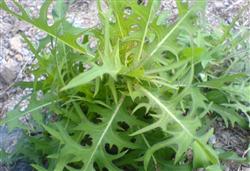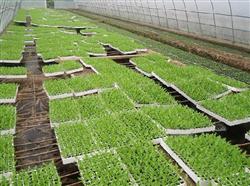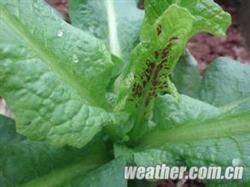Cultivation and utilization of lettuce

Mountain lettuce, also known as mountain lettuce, bitter chicory, duck food, is a herb of Compositae, born on roadsides, wilderness and hillsides. Its seedlings, tender stems and leaves are suitable for eating, and it is a kind of wild vegetable with development value. 1 Botanical and biological characteristics 2-year-old herbs with white milk and high 80~150cm. Stem erect, usually glabrous, simple or upper part branched. Leaves sessile, base slightly clasping, leaf blade lanceolate, linear-lanceolate to linear, glabrous or slightly hairy on abaxial main veins, not divided to pinnately or inversely pinnatifid or parted, lobes with notched or serrated needles at margin, lower leaves withering at anthesis. Heads yellowish or whitish, open at noon, closed at night, and then arranged into a panicle; involucral bracts outermost ovate, inner oblong, obtuse. Achenes flat, dark brown, apical beak ca. 0.7mm, with only one obvious longitudinal rib in the middle; crown hairs white. The flowering and fruiting period is from July to October. Mountain lettuce likes temperature, drought resistance, fear of waterlogging, fertile and suitable humidity plots grow well. (2) cultivation techniques 2.1 protected cultivation 2.1.1 soil preparation and fertilization: the cultivated land was used as a border, and the rotten organic fertilizer 10cm was applied to the surface layer of the border. Turn 25cm deeply and rake flat. 2.1.2 greenhouse seedling: the seedling soil is sifted with 4 parts of soil, 4 parts of rotten organic fertilizer, 1.5 parts of peat and 0.5 parts of river sand, put into the seedling plate, compacted for four weeks, and then scraped flat with wood strips, so that the soil surface is lower than the plate mouth 1~2cm, sowing, spacing 0.5cm, covering soil 1cm, pouring water after sowing, covering plastic film, the temperature is kept at 25: 30 ℃, after leaf tip exposure. Turn on the plastic film for ventilation. The seedlings were planted at 2cm, and the water was controlled 2-3 days before transplanting. When transplanting, insert 2cm deep pit on the border, spacing 4cm, put in the seedlings, cultivate the soil to compact, pour through water, properly shade, slow the seedlings and then remove the shading net. 2.2 Open-field cultivation 2.2.1 Land selection: select fertile, moist, loose, sunny sandy loam for sowing, plough the soil before sowing, apply organic fertilizer, fine and rake flat; make beds, strip sowing, on-demand sowing, sowing. It is better to sow on demand and strip sowing, which is easy to manage and make it high-yield. 2.2.2 sowing: soak the seeds in 50 ℃ water, stir for 30 minutes, control clean water, wrap them with clean gauze, accelerate germination under the condition of 30 ℃, rinse 2 seeds with clean water 3 times a day, and then direct seeding after germination, 1 seed per hole, covered with soil 1~2cm, slightly suppressed, covered with plastic film to make it moisturizing, heat preservation, conducive to seed growth, seedlings unearthed and then removed plastic film. 2.3 harvesting and management of mountain lettuce can be harvested and put on the market in a timely manner according to market needs. Harvesting can be done by stripping leaves or harvesting. Small area planting can be used to peel off leaves, that is, only peel off large leaves, leaving internal leaflets to continue to grow. Large area planting is mostly harvested, timely harvest, good palatability, but also conducive to regeneration, but also can improve yield and quality. Top dressing once per cut, and do a good job of ploughing and weeding in order to increase the yield. The last harvest should be close to the ground to avoid stagnant water and rotten roots, which is not conducive to next year's production. 3Nutrition composition and utilization of carotene 4.88mg per 100g fresh lettuce VB2 0.63mg 29mg, crude protein 2.25g, crude fat 0.74g, crude fiber 2.62g, calcium 0.7g, phosphorus 0.3g. 3.1 wash tender seedlings and tender stems and leaves and dip them in sweet sauce for raw food; or blanch them with boiling water, rinse slightly, then cold, stir-fry or make stuffing, or add noodles to steam, or dry for vegetables in off-season. 3.2 Medicinal whole herb, cold in nature, bitter in taste, has the effects of clearing heat and detoxification, promoting blood circulation and removing blood stasis, invigorating the stomach, and can treat appendicitis, tonsillitis, sores and furuncles, persistent food, postpartum blood stasis. ① appendicitis, tonsillitis, cervicitis, postpartum blood stasis, bleeding, hemorrhoids: mountain lettuce 9g 15g, water decoction. ② sore furuncle swollen poison: mountain lettuce fresh products smashed and applied to the affected area.
- Prev

Methods of sowing and raising seedlings of lettuce
Lettuce can be direct seeded, can also raise seedlings and transplant, spring and summer mainly to direct seeding, autumn and winter can also be direct seeding. 1. Soaking seeds to promote germination: when the temperature is high in summer and early autumn, seed germination is restrained. Soak the seeds in warm water for 3 hours, then wrap them with towels or gauze and place them in a well (20-30 cm above the water surface).
- Next

Aphids prevention is the key to control lettuce virus disease
Virus disease is the main disease of lettuce and lettuce, which occurs widely. At present, there is no ideal chemical control at home and abroad. Prevention should be given priority to, and agricultural measures should be taken to prevent and control aphids in time. Virus disease is caused by virus infection, mainly through aphid transmission in the field, agricultural operation juice contact infection. Sick plants...
Related
- Where is it suitable to grow horseradish in China? it is expected to see the middle altitude horseradish in Alishan.
- How to prevent tomato virus disease reasonably? (Control methods included)
- Many people like to plant towel gourd on the balcony. What are the main points of this method and management?
- What crops can chili peppers be mixed with?
- Fertilization techniques and matters needing attention in Tomato
- What are the grafting techniques for peach seedlings in spring?
- Harm and control methods of root swelling disease of Chinese cabbage
- What are the pests of sweet potatoes? How to prevent and cure it?
- Symptoms, causes and Control methods of navel Rot in Tomato
- The cause of "Cucumber rotten bibcock" in Farmers' planting Cucumber and its Control Plan

